The San Antonio Driver’s Guide to Post-Accident Repairs

How Our Lifetime Warranty Makes Us San Antonio’s Most Trusted Body Shop
Have you ever wondered if a minor crash could hide a bigger risk? We see small impacts mask serious problems that can put drivers and our company at risk. A quick, structured check after an incident matters more than many teams assume.
We explain how an immediate inspection documents damage, supports claims, and helps prevent repeat accidents. Our process protects people, property, and brand reputation while keeping uptime high and downtime low.
Even minor damage can hide mechanical faults that affect handling or braking. We never return a vehicle to service without a clear checklist and verified repairs.
Miracle Body and Paint Collision Center in San Antonio partners with us to ensure repairs meet industry expectations. Our training, tools, and audits make post-collision inspections consistent and reliable, reducing liability and boosting workplace morale.
Key Takeaways
- Immediate inspections document damage and guide next steps.
- Structured checks reduce liability with clear records and photos.
- Hidden issues from minor impacts can threaten driver safety.
- Consistent protocols support uptime and program goals.
- Local experts like Miracle Body and Paint back our repair process.
Understanding the stakes: costs, liability, and employee safety today
A prompt, thorough inspection after a crash protects people and reduces hidden financial loss.
Immediate checks help us quantify the true costs of an incident. Average claims approach $70,000 per crash, nearly double the typical workplace injury cost. That kind of exposure makes inspections a smart fiscal step for any company.
Inspections also limit legal liability by creating documented evidence that meets current regulations and industry standards. Clear records of damage, repairs, and approvals make claims defensible and show we follow best practice.
Why post-collision inspections protect drivers and companies right now
Timely inspections show employees we put their well-being first. Transparent processes support morale, help retain staff, and build a safer workplace culture.
Real-world impact: crash costs, morale, and brand reputation
Frequent low-severity accidents still add downtime, rental fees, and admin costs. A consistent inspection program keeps those costs in check and protects our brand by showing customers we respond responsibly.
- Financial clarity: documented losses help control future costs.
- Reduced liability: standards-aligned reports support claims and audits.
- Employee confidence: fast, transparent action reinforces trust.
- Operational insight: data from inspections reveals systemic risk and training needs.
When we need fast, reliable repairs in San Antonio, Miracle Body and Paint Collision Center helps us return units to service safely and to our standards.
How to conduct a post-collision safety inspection step by step
After a crash, our first task is a clear, step-by-step inspection that preserves facts and protects people.
We start at the scene: secure the area, check for injuries, call emergency services if needed, and activate our incident response card.
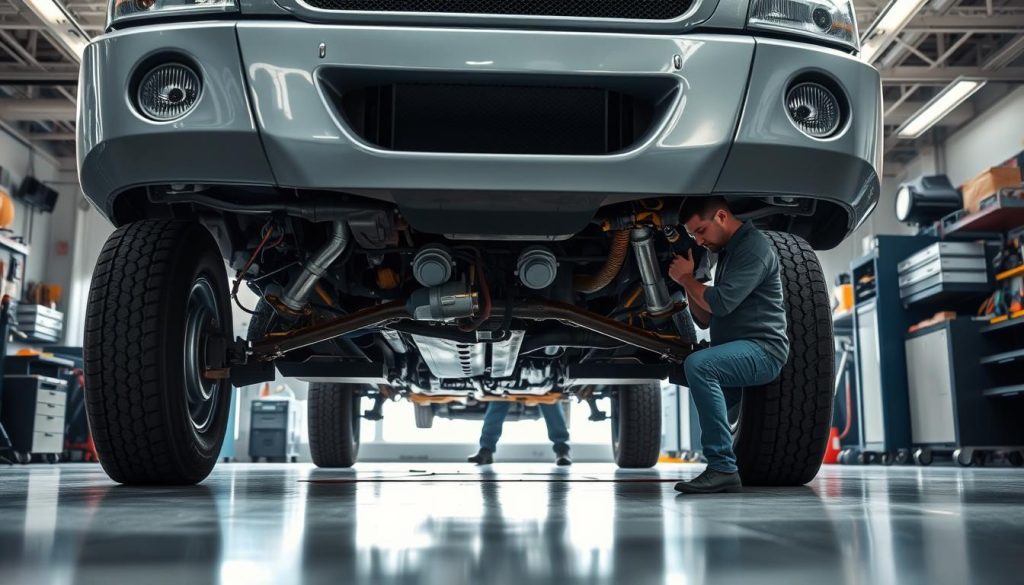
Immediate scene actions
We gather facts fast. Time-stamped photos, short videos, witness notes, and road and weather conditions are recorded.
The essential DVIR-based checklist
Our DVIR covers identification, exterior, interior, and under-hood checks. This standardizes reports and speeds claims and repair ordering.
Mechanical priorities
We inspect brakes, tires, lights, and steering first. These checks reduce the chance of a secondary incident and guide maintenance priorities.
Documenting defects and next steps
We tag defects with photos, measurements, and notes. Digital tools help assign actions, attach media, and keep records for compliance.
- Escalate out-of-service items: remove units until repairs are verified.
- Debrief drivers and supervisors: align on training and policy updates.
- Schedule repairs: share documentation with Miracle Body and Paint Collision Center in San Antonio for expert fit and finish.
Fleet Vehicle Safety integration: turning one incident into safer operations
Every incident can teach us how to reduce risk across the whole operation. We formalize findings so one inspection informs broader practices and improves our safety program.
We convene a cross-functional safety council to review root causes and assign corrective actions. That group meets regularly to turn data into clear changes in policies and training.
From single inspection to fleet-wide learning: councils and root-cause reviews
- Review: analyze preventable and unpreventable incidents.
- Benchmark: spot patterns by route, time, and incident type.
- Prioritize: manage by exception to focus on high-impact issues.
Updating written policies, driver training, and enforcement consistently
We standardize how findings are shared and update written policies. Targeted training modules—defensive driving refreshers, incident response drills, and routine maintenance practices—address gaps quickly.
Accountability matters: we name who updates documentation, audits compliance, and verifies corrective actions. That keeps our program tied to company goals like uptime, claim reduction, and reputation.
Tools and data that elevate post-collision inspections
Smart tools help us spot trends, coach drivers, and speed repair approvals with local partners.
Dash cams and telematics: objective evidence and coaching insights
Dash cams capture incident footage that protects drivers and clarifies fault for claims and repairs.
Telematics flags harsh braking, sharp cornering, and speeding so we can target coaching. We forward synced media and logs to Miracle Body and Paint Collision Center to speed accurate estimates.
Driver safety scorecards and benchmarking to reduce repeat incidents
Our driver scorecards standardize how we measure speeding, seat-belt use, and aggressive events.
Benchmarks compare performance to similar operations so we know where to focus training and update standards.
HOS and fatigue monitoring to address drowsy driving risks
HOS alerts and fatigue indicators give real-time warnings. We intervene early — adjust schedules or reassign runs — to lower risk.
- Integrated inspections: digital checklists require photos and notes for high-quality documentation.
- Data workflow: evidence flows from incident to investigation to repair authorization without delays.
- Governance: retention timelines and compliance rules protect privacy and meet regulations.
Program KPIs track collision rates, preventable incidents, and out-of-service days on dashboards. We pick solutions that match our culture so drivers and supervisors adopt them and driving performance improves.
Compliance, maintenance, and cost control after an accident
We close the loop by pairing our compliance controls with a clear inspection and repair pathway to lower downtime and cost.
Formal plans stop minor damage from becoming major failures. A written inspection, repair, and maintenance plan reduces breakdowns and the chance of repeat incidents.
Formal inspection, repair, and maintenance plans to prevent failures
We codify the post-incident path: inspection, estimate, authorization, repair, and verification. Each step has an owner and a sign-off so audits and insurers see a clean record.
- Schedule follow-up maintenance after repairs, including alignments, fluid services, and system calibrations.
- Standardize checks for brakes, tires, and lighting to prevent secondary faults across our units and locations.
- Partner with local services like Miracle Body and Paint Collision Center to ensure quality repairs and parts availability.
Screening, managing, and retraining drivers to lower risk and costs
Core elements of our fleet safety program include driver ID, screening, training, and ongoing management. We strengthen MVR reviews and retraining pathways so the right people drive and know safe driving fundamentals.
- Pair coaching with policy enforcement to correct risky behavior and reduce total cost of ownership.
- Define program elements and responsibilities so the organization knows who approves repairs and who signs units back into service.
- Track outcomes—downtime, repair rework, and preventable incidents—to improve program performance and prioritize investments.
We align with applicable regulations, document compliance, and schedule routine maintenance to return vehicles to service without compromising safety.
Conclusion
A disciplined inspection program turns a single crash into a chance to improve operations and prevent future harm.
Consistent post-collision inspections are the foundation of strong fleet safety. They protect people, assets, and our reputation while helping the company meet regulations.
Pair structured checks with driver safety coaching and targeted training to embed a proactive culture. Use dash cams, telematics, and scorecards so accidents become clear lessons that improve performance over time.
Hire Miracle Body and Paint Collision Center to repair your collision damage. We have two San Antonio locations: North West — Leon Valley, (210) 680-1987, 6217 Grissom Rd., San Antonio, TX 78238; North East — (210) 858-3630, 4650 Walzem Rd, San Antonio, TX 78218.
Call either shop today so we can match estimates to inspection records, speed approvals, and return your vehicles to service quickly. Thank you for prioritizing safety and trusting partners who share that commitment.

